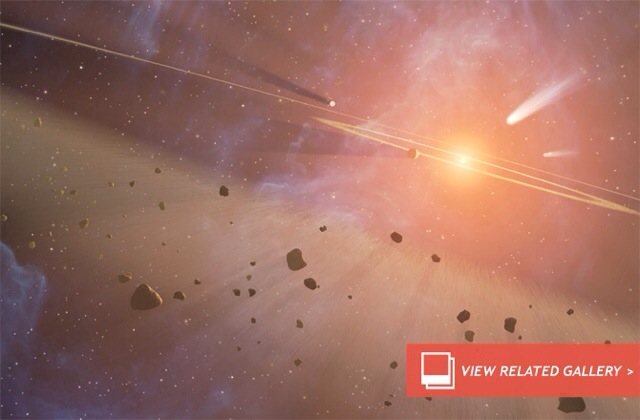
There’s something very very odd floating around in the outer solar system. Actually, there’s lots of odd things floating around in the outer solar system, but 2002 UX25 is one of the most baffling.
The mid-sized Kuiper belt object (KBO) measures 650 kilometers (400 miles) across, and yet it has a density less than water (less than 1 gram per cubic centimeter). Yes, if you put it in a huge bathtub, 2002 UX25 would float.
As we probably all know by now, the Kuiper belt — a populated region of the solar system found just beyond the orbit of Neptune — is a strange place. Once thought to have a population of just one, astronomers have identified thousands of other minor planetary bodies. In fact, it was the accelerated discoveries in the Kuiper belt that ultimately led to the reclassification (or demotion, depending on which way you look at it) of Pluto from “planet” to lowly “dwarf planet.”
This finding adds an extra twist to a strange dichotomy of KBOs. Objects with diameters less than 350 kilometers (218 miles) generally have densities less than that of water; objects over 800 kilometers (500 miles) have densities greater than water. One point in the gray area — between the diameter range of 350-800 kilometers — has just been added by 2002 UX25. But it is very large to have a density 18 percent less than water ice.
It is thought that KBOs formed in a similar way to asteroids and planets. Over the evolution of our solar system, small bits of rocky and icy debris coalesced, eventually forming planetesimals that then gathered more and more debris as their gravitational oomph grew. In this scenario, one would expect the density of minor planetary bodies to increase with increasing mass; the gravitational pressure of progressively larger bodies would cause more compression, thus increasing the density.
However, the very low densities of smaller KBOs are hard to explain without assuming that the bodies have a high degree of porosity. Porosity is a known factor in the formation of asteroids throughout the solar system — gaps throughout the structure of rocky bodies less than 350 kilometers in diameter are thought to lower the overall density. Asteroids over 350 kilometers become so massive that porosity decreases; the gravitational compression pulls the material closer together, reducing porosity and increasing density.
According to Brown, this porosity transition should occur in KBOs larger than 350 kilometers wide. But as 2002 UX25 shows, this transition hasn’t happened up to a size of 650 kilometers. This factor creates a problem. If larger KBOs over 1,000 kilometers (620 miles) formed through the coalescence of smaller KBOs (like 2002 UX25), it isn’t possible that large rock-rich KBOs could have such high densities.
In the case of an object the size of Eris, for example, with a measured density of 2.5 g/cm3, even with the gravitational compression exerted by the 2,326 kilometer-wide dwarf planet, the low density, high porosity material from an objects like 2002 UX25 cannot be compressed to such a high degree. Such an object “would still have a density close to 1 g/cm3 rather than the 2.5 g/cm3 density of Eris,” writes Brown. On this evidence alone, large KBOs cannot form through agglomeration of many small KBOs like 2002 UX25.
Source: Discovery News
Originally posted 2013-11-13 20:10:19. Republished by Blog Post Promoter

![20131113-210722[1]](https://coolinterestingnews.com/wp-content/uploads/2013/11/20131113-2107221.jpg)










